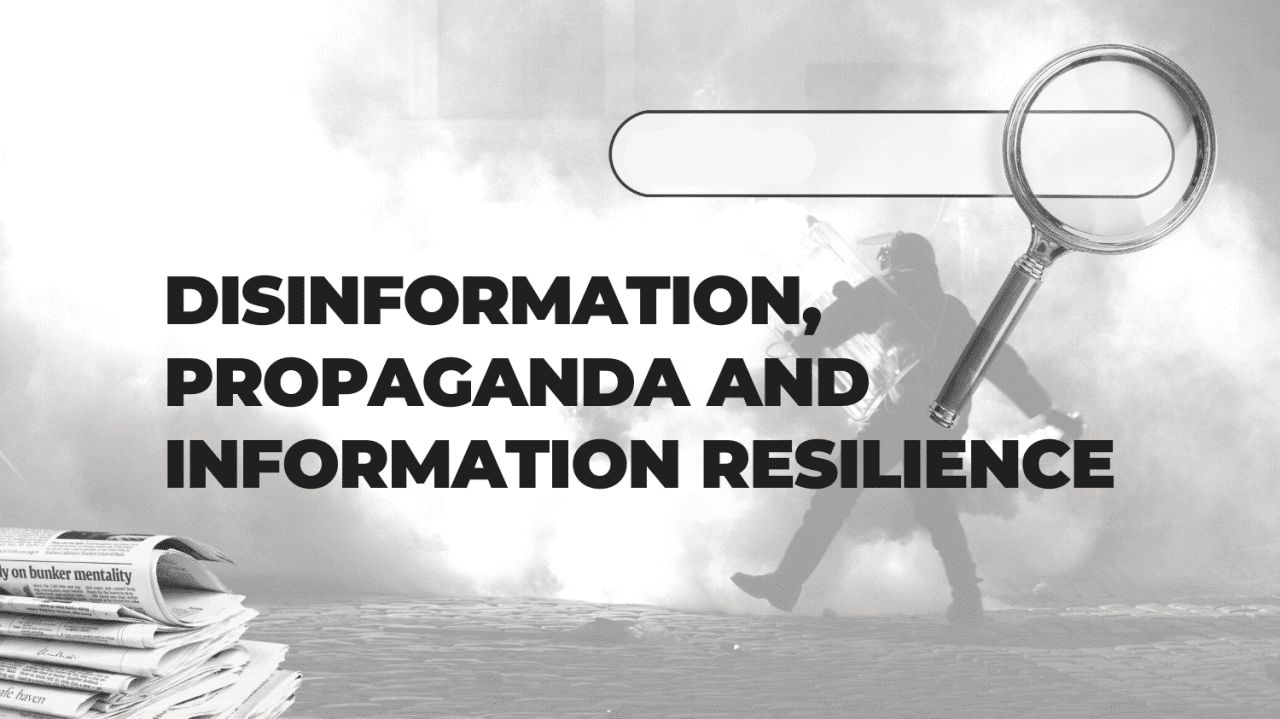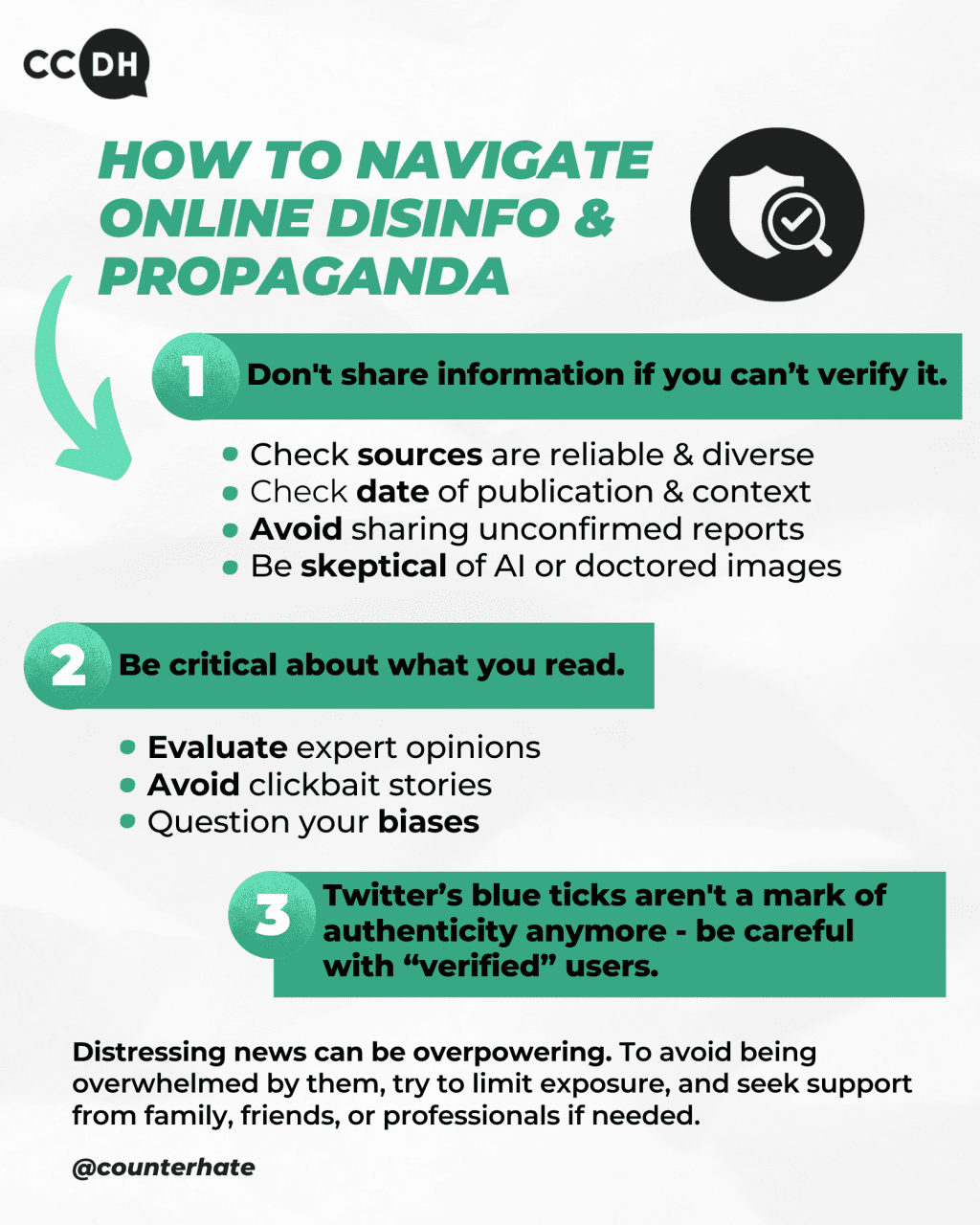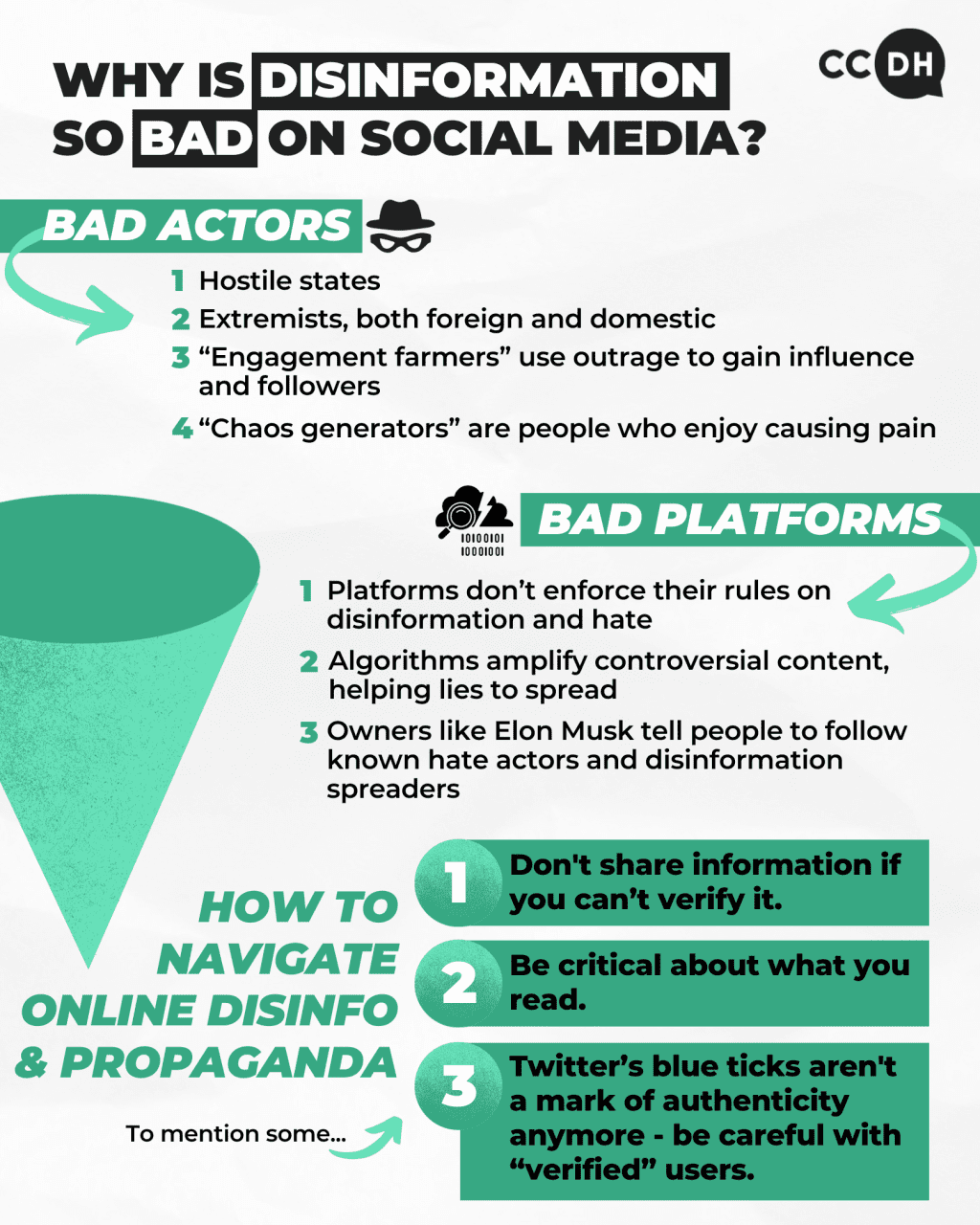How to navigate online disinformation and propaganda and practicing information resilience

During terrorist attacks, war, conflict, emergencies, and disasters the online information ecosystem can be difficult to navigate.
We live in a 24-hour news cycle, driven by social media and online news which is amplified in our news feeds and curated by opaque algorithms.
Certain complex sets of bad actors use social media during crises to spread misinformation, disinformation, and propaganda. The amplification of this content is part of the business model of social media platforms.
Here is some practical advice on how to avoid spreading misinformation, disinformation and propaganda, how to increase your own information resilience, and importantly, how to practice some self-care.
Avoid Spreading Mis/Disinformation and Propaganda
First principle:
If you can’t verify that information is correct and legitimate – and that it is helpful to share – then don’t share it.
Don’t share distressing content:
Some people share distressing videos of violence, in order to highlight their horror at what has been happening. However, while the sentiment may be well-meaning, it may help to spread content that is often made for an ulterior motive or the purpose of propaganda. Victims will not have given consent to be filmed or photographed, so don’t share it. If you want to raise awareness, write about what you are seeing, and follow the advice below.
Verify information before sharing:
Always verify the source and authenticity of the information you’re sharing to the best of your ability. Cross-reference facts with reliable news outlets to confirm the accuracy of the content. Social media is not a reliable way to confirm accuracy, since it is far more prone to containing disinformation than major news outlets which are subject to professional codes of conduct, and can be held liable under the law for harm.
Check dates and context:
Before sharing any content related to the current crisis, check for the publication date and ensure that the context is current. Old footage or images can be misleading and are often circulated at times of informational chaos, when a crisis strikes.
Be skeptical of non-expert accounts:
Be cautious of sharing content from unverified or anonymous social media accounts. Reputable journalists or established news organizations are more reliable sources of information.
Be skeptical of AI or doctored images:
The recent proliferation of advanced AI tools into everyday life has made information resilience more complex. AI images, audio, and video can now be generated very easily by regular people. Some things you see online may be fake or generated by AI tools.
Avoid sharing unconfirmed reports:
Don’t amplify unverified or unconfirmed information, rumors, or conspiracy theories. Wait for official statements or credible news sources to report on the situation.
Report false information:
If you encounter content that appears to be false or misleading, report it to the platform as potentially harmful content. We know platforms can be bad at enforcing their own rules. But if you come across false, misleading, or violent content that you think shouldn’t be online, then reporting it is a positive first step.
Twitter isn’t the platform it used to be:
X, formerly known as Twitter, used to be the go-to social media platform for breaking news. But it isn’t the platform it used to be now that Elon Musk is in charge. Blue tick verification used to be a mark of authenticity for news reporters and news organizations. Now anyone with $8 a month can buy a blue tick to give the veneer of authority and algorithmically boost their content. On top of this, accounts that were linked to Foreign State media, such as Iran’s Press TV, are no longer labelled as a state-affiliated account.
Twitter used to have teams that curated accurate information from verified sources, and provided important context to trending topics online. These teams don’t exist anymore – Musk let them all go. There have been recent changes to how news articles appear in your feed. Images are no longer accompanied by a headline, description and prominent web address of the website. This can make verifying the source, and evaluating the opinion a bit more difficult.
Don’t feed the Trolls:
Unfortunately, a litany of trolls emerge in times of crisis online. People who are content to weaponize the situation to spread their own political or social goal, whether that be antisemitism, spreading conspiracy theories, glorifying violence, or ‘Whataboutery’ where someone responds to a difficult point by raising a counter accusation or different issue, asking “well what about this?” – a common tactic used by misinformation spreaders.
Whatever you do, don’t feed the trolls. They thrive on getting a rise out of people who feel compelled to defend or correct their views. It also helps to amplify their content to a wider audience they wouldn’t have reached otherwise. Block or mute trolls, and report their content if it is breaking platform T&Cs. Mobilize friends to report rule-breaking content as well, but never engage with it.

5 Ways to Increase Information Resilience:
Diversify your news sources:
Follow a variety of reputable news outlets to get a more complete view of the situation. Avoid echo chambers that reinforce one set of beliefs.
Fact-check information:
Familiarize yourself with fact-checking websites and tools. Or if you see a report, check it on other reputable websites to see if they are reporting it too.
Evaluate expert opinions:
Listen to experts, scholars, and analysts who have in-depth knowledge of the situation. Their insights can provide valuable context and understanding. A loud opinion online doesn’t make you an expert. This week’s ‘Middle East Geo-Political experts’ were often last week’s vaccine ‘experts’. Everyone’s got an opinion, and not all opinions are equal.
This point is too good to be missed, avoid clickbait:
Be mindful of clickbait headlines, sensationalism, and bias in reporting. Clickbait headlines and sensationalism might sound intriguing, but they’re probably trying to drive your click to their website to make a quick buck via ads they’ll serve you up.
Question your biases:
Be aware of your own biases and how they might influence your perception of information. Try to approach news with an open mind.
To Practice Self-Care
Set boundaries and take breaks:
Limit your exposure to distressing content and avoid constantly refreshing your social media feed. Periodically step away from social media, especially during times of crisis, and set specific, time-limited periods you will check in on social media. Maybe take a break from social media completely for the duration of the crisis, or limit your accounts to being open to friends and family only. Avoid exposure to distressing content when you are feeling tired or down, or when you are alone with no one to talk to.
Talk to someone, and talk to your kids:
If you find the content distressing, discuss your feelings with a trusted friend or family member. Sometimes, sharing your concerns can help alleviate stress. Our children are on social media too, and for some they may be checking social media, worried about the situation, friends, or family. Take a moment to speak to your children about what they are seeing on social media and online. Talk to them about the points in this article and help contextualize what they might be seeing.
Seek professional help:
If you find yourself struggling to cope with the distressing images and information, consider speaking to a mental health professional.
Remember that in times of crisis, it’s crucial to prioritize responsible sharing of information, accurate reporting, and self-care. By following these guidelines, you can build your own resilience and help create an information ecosystem that prioritizes truth over lies.

Join our email community to receive updates on our latest research, campaigns, and explainers.